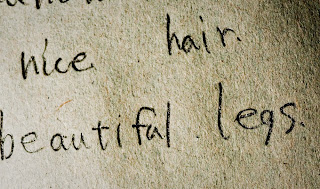
This is a lesson I did with my students at Iwaki High school last week. It’s sort of based on a project that I did with my classes during my practicum back home. The lesson is based on practicing compliments, developing vocabulary, and then writing a compliment to the principal, which I give to him at the end of the week. At this school, I have 8 classes of 40 students, which equals 320 compliments. This lesson works particularly well in my situation because our principal used to be an English teacher. If this doesn’t get me in good with the staff at the school, I don’t know what will. This lesson was designed for a first-year secondary class. Feel free to use as much or as little of it as you like.
I begin the class by saying “good morning” and having the students respond back. I tell them “your pronunciation is very good.” Then I tell them that they are “listening very well.” Then I tell one student that he/she has very nice hair today – and I go on to compliment pens or book bags. It’s usually pretty awkward for the student being complimented and is sometimes quite funny for the class. I then write the word “compliment” on the board and have students try to guess what it means.
Once we figure out the definition, we practice some compliment dialogue provided in our textbook. We use Communication I textbooks. After going through this a few times, I write 4 compliment formulas on the board:

-You have [a] (adjective) + (noun) . (singular)
-You have (adjective) + (noun)[s] . (plural)
-You are a (adjective) + (noun) .
-You (verb) + very well.
I then have the students practice these phrases by writing a compliment with each formula about their partner. We share a few afterwards, which is sometimes funny. I find that the students that really shine during this activity are the boys who are partnered up with a girl: “you have a beautiful smile – although this is usually the exception and not the rule. Most students make use of the example adjectives that I use on the board, which are usually, “nice,” “great,” and “beautiful.” We usually end up with a class that responds with “you have a nice pen,” or “you are a nice person.”
In order to build stronger compliments and to develop some vocabulary, I pass around Japanese-English dictionaries and ask the students to think of great adjectives in Japanese and then to translate them into English. I know what you’re thinking, give a kid a dictionary and you’re just asking for trouble. I remember at that age whenever a dictionary came into our hands, we would look up every dirty word imaginable – and then we would try to find more. Many of these students were no different – and It was awesome.

I managed to get 20 dictionaries from the English office and our library, so the students worked in pairs. I think most schools should have at least a couple of these books in the library, but the groups may need to be larger if only a small number can be found.
Afterwards, I go around the class and write down as many new adjectives as possible.
Now that we have a ton of new adjectives and a bunch of dictionaries at hand, I pass around a slip of paper to the students. I explain that we will write a compliment to the principal and that at the end of the week I will deliver a box of 320 compliments to his office. I ended up taking to volunteers with me on the day to offer it to him in English. I think that he was quite pleased and very impressed.

We only had a few minutes with him, but he read about a dozen of them and then said that he had to stop because he would start to cry.
Here is a list of my favorite compliments in the order that I received them – mistakes and all. The beginning of each phrase began, “Principal Yamanouchi…”
you have a good camera
you are the greatest teacher in the cosmos
is a man amongst men
has a cute pencase
you have a lovely face

you have beautiful eyes
you have a parfect body
has very nice students
you are a genius
is a reliable person
you have a great brain
you have a muscular body
you are a elegant gentleman
you have very great neckties
you are a cool face
you are a very reliable teacher
you are a sexy man!

your words is great!
you have elegant glasses
you are a nice smile
you have a large mind
you a clean person
you are a hairy clab
you say “good morning” very well
you have a great car
thanks you for working for our high school very hard
you sing songs very beautiful
you are very tender
you have a very useful bag

you have a great high school
you have wonderful teachers
you have an unshakeable belief, I feel.
you are a dignified man
you have a strong sense of responsibility
you have good leadership ability
you are a attractive person
you are a sincere person
you are a fantastic teacher
you are gentle
you are very ingenius
you are a necessary person
you nave a gallant face

you are very fresh
I have never seen a keen teacher such you
you guide us to the right path
you have a attractive personality
you are a noble
you are a playful person
you are a very mild man
you have a tough heart
you have a brave beard
you are beautiful like mathematics
you get the respect of the students
you have splendid glasses
you are very youthful

you are very marvelous
you are a brilliant person
you are kind to students always
you are very dandy
you are very gentlemanly
you are a very rich person
you are a well-informed person
you have nice subordinates
you have a bright smile
you are a erotic man
you are polite. I look up to you
you have a sexy girlfriend
you are a very handsome man
you are an invincible
you make speech eruditely
you are a wild person

 While I was in Aizu, we visited the Byakkotai (White Tiger Company) shrine on Limori Hill.
While I was in Aizu, we visited the Byakkotai (White Tiger Company) shrine on Limori Hill. ( Nagase was too injured to do it himself.) Hayayhi asked Komashiro Nomura to execuse him. Then, all the young samurai committed harakiri on Iimori Hill. The exact spot where they did this was on a narrow slope. It is important to note that since there was no one else to aid them in their Harakiri. They all died a slow, agonizing death. (http://www.ne.jp/asahi/minako/watanabe/byakkoeng.htm)
( Nagase was too injured to do it himself.) Hayayhi asked Komashiro Nomura to execuse him. Then, all the young samurai committed harakiri on Iimori Hill. The exact spot where they did this was on a narrow slope. It is important to note that since there was no one else to aid them in their Harakiri. They all died a slow, agonizing death. (http://www.ne.jp/asahi/minako/watanabe/byakkoeng.htm)



















































